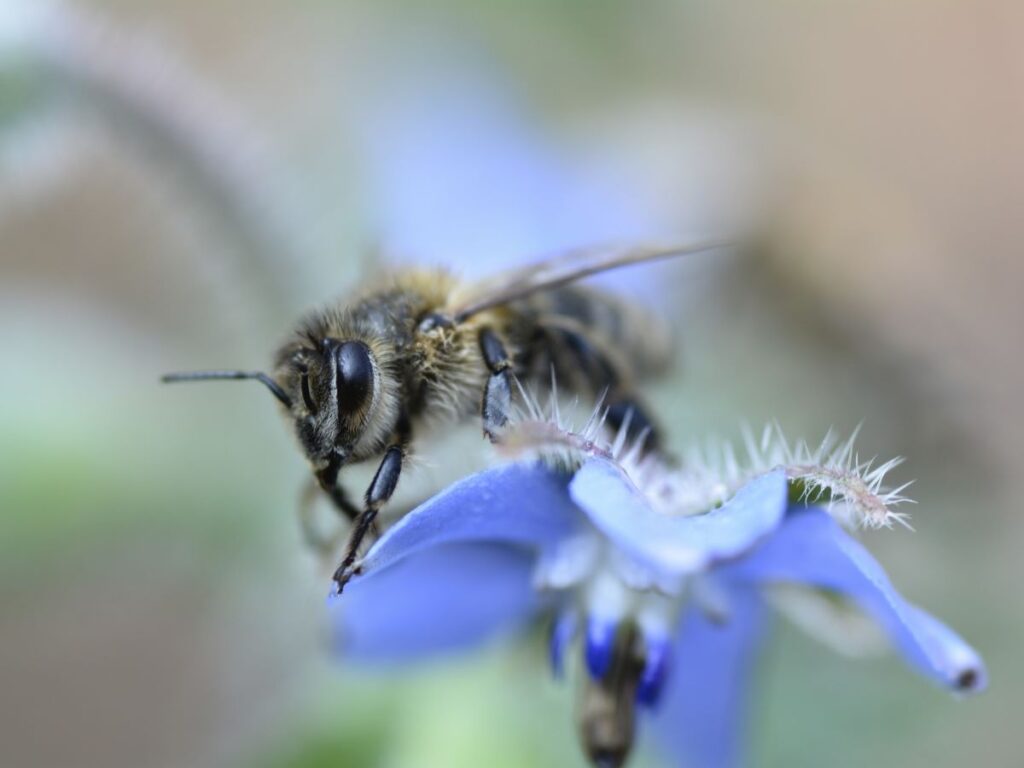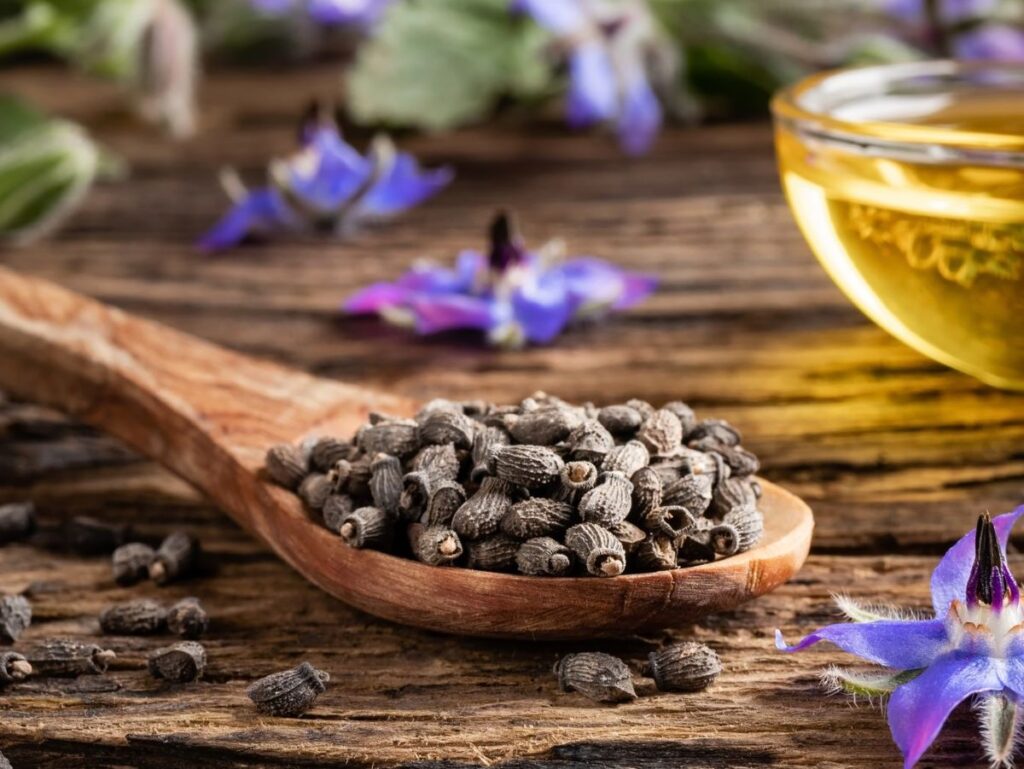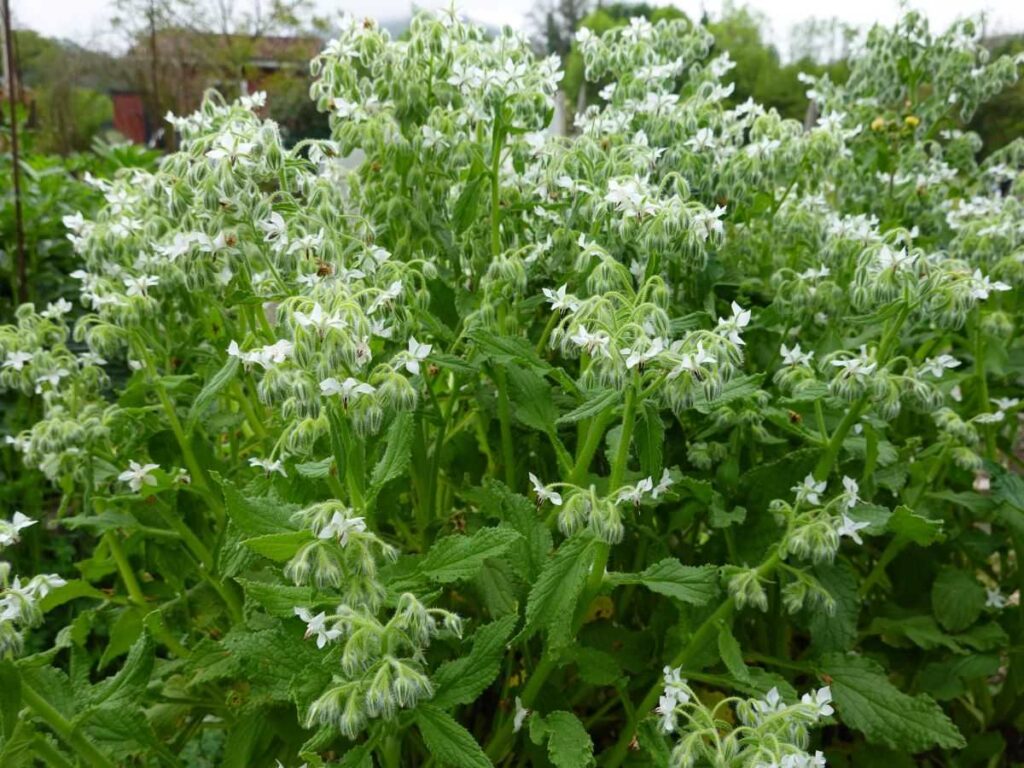I love borage for the charm and depth it adds to a herb garden with its stunning blue flowers and tall bushy shape. This annual herb, also known as starflower, is prized for its cucumber-like taste in recipes. Borage is highly valued as a companion plant to attract bees, butterflies and other garden pollinators. Best of all, borage is easy to grow and tolerant of a wide variety of garden conditions. Here’s your step-by-step guide to how to grow borage.

Borage (Borago officinalis) is a renowned herb notable for its agricultural and culinary applications. Characterized by its rough, hairy leaves and stems, borage is a hardy annual from the Mediterranean region. The plant’s most distinctive feature is its striking blue, star-shaped flowers, which bloom throughout the summer. These flowers serve a vital ecological role by attracting pollinators to the garden.
Borage’s Benefits and Uses
Borage is a multifaceted herb with significant horticultural and culinary qualities. Because it is also very easy to grow, it is a popular herb in gardens.
- Culinary uses of borage are diverse. Its leaves possess a mild cucumber-like flavor and can be used in salads or as a garnish. The vibrant flowers are often crystallized for confections or used as a decorative and flavorful addition to beverages and dishes.
- According to WebMD, borage is also recognized for its medicinal properties. Historically, it was used to improve adrenal function and as a diuretic. It is also known for its anti-inflammatory effects.
- In the garden, borage is valued as a companion plant that attracts pollinators. It’s exciting to watch the bees and butterflies flit around these beautiful flowers.
- And what I love most about borage is using it as a background plant in a herbal garden. The taller height and long bloom time provide a gorgeous backdrop to other herbs in your flower bed.
You’ll love having borage in your herb garden. So let’s take a look at how to grow borage next.

Getting Started Growing Borage
Borage is easiest to grow by planting seeds directly into your garden. It germinates quickly, less than 2 weeks from planting, and grows fast. Many gardeners will plant a second crop 4 to 6 weeks later to extend the bloom time.
While you can start borage seeds inside, most gardeners don’t bother. Borage has a long tap root making it difficult to start in shallow seed trays or small pots. Occasionally you’ll find borage in nursery pots and as long as the pot is deep you should be able to successfully transplant to your garden.
Starting Borage Seeds in Your Garden: Step by Step
Borage is easy to find in seed packets in your local garden center or hardware store. Feel free to collect seeds at the end of summer to store for your garden next year. You might also find borage self-seeding in warmer climates, sprouting up plants in the same spot they grew last season.
- Choose the right location: Borage thrives in full sun with partial shade. To get the most blooms and sturdy stalks, provide more sun than shade.
- Prepare the soil: The ideal soil pH is 6.5, but borage will grow in soil with a pH between 4.5 and 8.5. Ensure that the soil is well-drained. You may need to work in some well-rotted manure or compost into the soil to improve drainage.
- Sow seeds directly into the garden: After the last date of frost, plant seeds ¼ to ½ inch under the soil in rows 12 inches apart.
- Germination: Borage seeds will typically germinate within 7-14 days. Keep the soil consistently moist but not waterlogged during this time.
- Thinning: When the plants measure 4 to 6 inches tall, thin the borage to at least 1 foot apart to prevent overcrowding and ensure healthy growth.

Starting Borage Seeds Indoors
In no time, you’ll have strong healthy borage plants in your garden.
If you decide to start borage seeds indoors to get an early start on the summer bloom here are a couple of tips to help you with a successful planting:
- Start seeds in 3 to 4-inch biodegradable peat pots that can be planted directly into the ground. That way you don’t damage the tap root when transplanting.
- Plant your seeds no more than 4 weeks prior to moving outside so the roots don’t get too big for successful transplanting.
- Dig a hole 8-10 inches deep to ensure there is plenty of loose dirt below the plant for strong root growth. Backfill with the loose soil. Then plant, pot and all, with the top level to the original ground level.
Borage seeds are easy to germinate with very little attention making it fun to grow in your garden. This is a plant that kids will have great success with so feel free to involve them also.
Where to Plant Borage
Borage is not a picky plant and will grow under less than ideal conditions as long as it isn’t in heavy shade or very wet soil. However, it does grow larger and produce more flowers when planted in its ideal conditions.
Best Conditions for Planting Borage
Borage grows best in well-drained soil with a medium pH range. Although the ideal soil pH is around 6.5, this resilient herb can grow in a pH range of 4.5 to 8.5. You can enrich the garden bed with average organic matter to help support healthy growth.
Borage thrives in full sun or light shade. However, more sun is better as it encourages abundant blooms and sturdy stalks.
Borage can grow in zone 5 and above. Don’t plant outside until your area is past the last frost date as the young seedlings and plants won’t survive a spring frost.
Planting Borage in Containers
If you’re short on space or prefer container gardening, borage can be easily grown in pots on your patio or deck. Because of its size, borage isn’t a good choice for a kitchen window herb garden. Here’s how to get started with planting borage in containers:
- Select a deep container, at least 12 inches depth, to allow the tap root to grow. Also, keep in mind that borage gets tall and full so a bigger pot provides better weight balance for this large herb.
- Choose a container with proper drainage holes to prevent waterlogging.
- Use a high-quality potting mix that is well-draining.
- Place the container in a spot with full sun to light shade.
Remember to be cautious when transplanting borage seedlings, as they develop taproots quickly, and damaging the root can hinder their growth. Stick to these guidelines and your borage will flourish, regardless of whether it’s planted in the ground or a container.

Herbs to Plant with Borage
When planning what other plants to include in your herb garden along with borage you are looking for ones that thrive under similar conditions. Rosemary, thyme and sage will grow well in the same bed as borage.
Borage is a great addition to a butterfly herb garden as the bold blue flowers are a super-attractant. It will also thrive in light shade making borage a critical plant in a shaded herb garden.
Caring for Borage in Your Garden
Borage is relatively low maintenance once established in your garden. Here are a few tips on caring for it throughout the summer.
Watering and Fertilizing
Keep the soil evenly moist but not overly saturated. Mulch can help retain moisture and prevent weeds. Borage plants benefit from an occasional boost of fertilizer, especially if the soil is lacking in nutrients. You can use a balanced, organic fertilizer or add a layer of compost to give your plants the nourishment they need.
Pruning and Deadheading
Pruning is not typically necessary for borage plants, but you can trim them back if they become too large or leggy. Deadheading, or removing spent flowers, will encourage new blooms and keep your borage looking its best. When flowering has ended, collect and save the seeds for the next season or allow them to self-seed in the garden.
Common Pests
Pests on borage are unusual. But if the plant is under stress a few bugs might sneak in for a snack.
Aphids. These tiny insects suck the sap from the plants, causing stunted growth and a loss of vigor. If you do have aphids, they will be seen on the stems of new growth. To manage aphids effectively, use insecticidal soap or neem oil to control their population.
Disease Management
Borage plants are susceptible to powdery mildew and root rot. Both of these diseases thrive in damp, shady conditions, so ensure your borage is planted in well-drained soil and gets an adequate amount of sunlight.
If you see signs of damage, remove any affected plant material and dispose of it away from your garden. It will also help to thin out some of the plants to allow for better air circulation.

Common Varieties of Borage
There are a few varieties of borage that you can consider adding to your garden:
- Common Borage (Borago officinalis): The most widely known variety, this type produces blue flowers, and the entire plant has a cucumber-like flavor.
- Creeping Borage (Borago pygmaea): This variety is a smaller, trailing version of the common borage, perfect for containers or hanging baskets.
- Comfrey (Borago comfrey): While not a true borage, comfrey is often associated with borage due to its similar appearance and beneficial properties.
- Variegata Borage (Borago officinalis ‘Variegata’): This variety has variegated leaves, which can add an attractive touch to your garden.
- Alba Borage (Borago officinalis ‘Alba’): This variety is unique as it produces white flowers instead of the traditional blue, offering a lovely contrast in your garden.
By incorporating different varieties of borage into your garden, you can enjoy the variety of textures they provide to the garden landscape.
Culinary Uses for Borage
The list of ways you can use borage in the kitchen is long and nearly unlimited. Here are a few popular suggestions:
Salad Ingredient:
Borage leaves and flowers can add a refreshing cucumber-like flavor to green salads. The vibrant blue flowers also contribute a pop of color.
Garnish:
The bright blue flowers are edible and can be used to garnish cocktails, lemonades, and desserts.
Soup Flavoring:
Young borage leaves can be used to flavor soups and stews. They should be added towards the end of cooking to maintain their delicate flavor and texture.
Pesto Base:
Borage leaves can be blended with garlic, nuts, parmesan cheese, and olive oil to create a unique variation of pesto sauce for pasta or as a spread.
Infused Vinegar:
The leaves and flowers of borage can be steeped in vinegar to create a beautifully tinted infusion. The subtly flavored condiment is perfect for dressings and marinades.
Companion for Fish:
Borage pairs well with fish dishes. Use, either as part of a sauce or simply as fresh leaves and flowers sprinkled over the top for an added herby and slightly cucumber-like taste.

Companion Planting
What to Plant Near Borage
Borage is a fantastic companion plant for several vegetables and fruits. Planting borage alongside strawberries, tomatoes, squash, and beans can improve their growth and taste. Borage also helps to enhance the health of plants in the cabbage family.
Attracting Pollinators
One of the major benefits of growing borage is its ability to attract pollinators, such as bees and butterflies. The plant’s beautiful blue-purple flowers draw these insects to the nectar and pollen produced by the plant.
Deterring Pests
Borage not only attracts beneficial insects but also repels some unwelcome pests. The smell of borage is thought to deter tomato hornworms, a common garden pest that can cause significant damage to your tomato plants.
Frequently Asked Questions
According to the ASPCA, Borage is toxic when ingested by dogs, cats, and horses. It will cause vomiting, diarrhea, and dermatitis.
Borage is tolerant of a variety of soil conditions and doesn’t need special care as long as the soil drains well. Although not required, borage will benefit from an addition of organic matter. Ideally, the soil should have a pH of 6.5, but borage can tolerate a pH range from 4.5 to 8.5.
Yes, you can grow borage in pots. Because borage is a tall and large plant, the bigger the pot the better. Choose a container that is at least 12 inches deep and has drainage holes to prevent waterlogging. Place the pot in an area where the plant will receive full sun to partial shade.
Borage is an annual plant, which means it completes its life cycle within one growing season and needs to be replanted each year. You can either sow new seeds or plant young plants each year to enjoy borage.
Growing borage is a rewarding endeavor for any gardener looking to add both beauty and utility to their garden. With its striking blue flowers, resilience, and myriad of uses in the kitchen, borage is a versatile plant that enriches the environment it grows in. By following this guide to how to grow borage, this herb will bring a touch of whimsy and a host of benefits to your garden.

